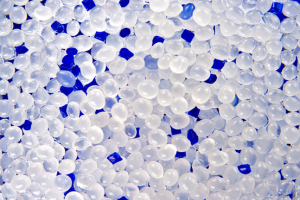If you look around you, you are bound to notice at least a few plastics in your surroundings – although you may not realise that they are made of polymers. What are polymers? Examples and applications of these popular substances can be found below.

What are polymers?
Polymers are a specific type of chemical substances that are characterised by their high molecular weight. Moreover, they have a specific structure: they consist of repeating units called mers. The high molecular weight means that the detachment or attachment of a single mer does not significantly alter the chemical and physical properties of the compound. This is an important difference to oligomers (substances consisting of a small number of mers) – in their case, such a change can result in a different melting point, for example.
Polymers are associated primarily with plastics. In reality, however, this group of compounds is much broader. Besides synthetic polymers, which are the building blocks of plastics, there are also natural polymers, which are common in nature. They are one of the basic components of living organisms.
Chemical properties of polymers
Each polymer may have its own individual properties. It is possible, however, to distinguish several chemical properties of polymers which are common to all of them. These are as follows:
- Resistance to chemicals. For example, plastics used for packaging do not react with chemicals contained in them.
- Electrical and thermal insulation. Polymers are good insulators. It is from these that the materials used for protective layers on cables or for electrical sockets are produced. Their properties relating to thermal resistance allow these materials to be used in households, e.g. in pot handles.
- High strength while being lightweight. Some plastics are even able to float.
- Easy to process. Polymers can be processed in a variety of ways – they can be formed into thin layers (e.g. textile fibres) and solid backbone structures. They can be easily formed in a specific shape.
How are polymers produced?
The production of polymers can be performed using one of the two methods: polymerisation and polycondensation.
In the first process, a chain reaction takes place in which the monomers bind with each other. This is not accompanied by the formation of any by-products. For the polymerisation to take place, it is necessary to use an initiator – a substance that initiates the reaction, in which it is consumed. The linking monomers may originally be in the solid, liquid or gaseous phase. Plastics resulting from polymerisation include:
- LDPE and HDPE polyethylene,
- polyvinyl chloride (PCV),
- polypropylene (PP),
- polystyrene (PS).
Polycondensation produces a macromolecule, i.e. a polymer, plus, as a by-product, another substance, such as water, ammonia or hydrogen chloride. With this reaction, the polymer chain grows in a step-wise manner. Among the most popular plastics produced by polycondensation are:
- polyamides,
- phenol-aldehyde resins,
- epoxy resins,
- certain polyesters.
In the subsequent stages of plastics production, various types of additives, such as stabilisers or modifiers, are often necessary. With them it is possible to produce materials with specific properties. A wide range of additives for plastics can be found in the PCC Group portfolio, which is available on the Product Portal.

What types of polymers are there?
All polymers can be divided according to several criteria, e.g. by their origin, structure and shape and arrangement of their molecules.
Based on their origin, polymers can be:
- synthetic, i.e. they are produced entirely via chemical synthesis from monomers;
- natural, i.e. they are produced by living organisms; these include, for example, cellulose, proteins or nucleic acids;
- natural but modified by chemical reactions, e.g. cellulose acetate or modified starch are modified polymers.
Different types of polymers can also be distinguished based on their chain structure. There are, among others, linear, branched, ladder or cross-linked polymers. Furthermore, polymer molecules can have unusual shapes, similar to chain links or a tree.
Another classification is based on the number of different mers in one chain. If the chain is formed from a single type of mers, it is a homopolymer. If there are two or more of them, such compounds are called copolymers.
Most polymers are organic compounds. However, there is a fairly large group of inorganic polymers, i.e. polymers that do not contain carbon compounds. These include polysulphides, polysiloxanes or polyphosphazenes. On the basis of other characteristics of the structure, following types of polymers can be distinguished:
- polyolefins, consisting only of carbon and hydrogen and containing long carbon chains; this group includes polyethylene, polystyrene, polypropylene, among others;
- vinyl polymers, which also contain long carbon chains but are formed by breaking the bonds between carbon atoms; an example of this group is polyvinyl chloride;
- polyethers: polymers containing ether bonds;
- polyamides: polymers with amide bonds (−NH−C(O)−);
- polyurethanes: polymers containing urethane bonds (−NH−C(O)−O−);
- polyesters: polymers with ester bonds (−C(O)−O−);
- polycarbonates: polymers with carbonate bonds (−O−C(O)−O−).
An important feature affecting the applications of polymers is their molecular arrangement. Some substances can be amorphous, without any structure or order. They are usually transparent and thus can be used, for example, in the manufacture of packaging or contact lenses. In other types of polymers, the atoms are arranged in patterns forming crystalline structures. Such materials are opaque. The crystallinity of some polymers can be controlled to some extent, which alters their properties, e.g. by increasing their strength, stiffness and chemical resistance.

Polymers – examples of plastics applications in industry and construction
The most common polymers (polyester, polyamide or polyethylene) have already been named above. Now it is time to organise the information and show what different types of polymers are used for.
Today, there is virtually no field in which polymers are not used. They are utilized in medicine, electronics, cosmetics and they are probably in your household too. However, the areas in which they are used most frequently are industry and construction. Here are selected examples of polymer applications in these industries:
- phenoplastics – plastics based on resins formed in the polymerisation of phenol and formaldehyde, used in the manufacture of tool handles, brake and clutch linings, as an additive to varnishes, adhesives, binders;
- epoxy resins – thermosetting plastics used, e.g. in the production of laminates, metal adhesives, anti-corrosive and insulating varnishes;
- polyethylene – a component of various packaging materials: films, milk cartons, disposable bags;
- polypropylene – a popular component of wiring, medical equipment, technical fabrics, floorings, pipes, toys;
- polyvinyl chloride – used, among others, in the production of floor panels, pipes and hoses, and as an ingredient of adhesives and varnishes;
- polyamide – used in the production of nylon fibres, as well as gears, pressure pipes and other machine parts, packaging films, floorings;
- polycarbonate – due to its high strength, it is suitable for the production of transparent glazing: in closely-guarded buildings, aircrafts, space helmets or Formula one cars;
- polyurethane – used to create foams used in the furniture, automotive and textile industries, as well as in the construction industry for sealing.
Read also: classification of plastics according to application
- https://encyklopedia.pwn.pl/haslo/tworzywa-sztuczne;3990342.html
- https://www.britannica.com/science/polymer
- https://www.mdpi.com/2079-6412/11/7/747
- H. Mahmoodi Khaha, O. Soleimani*, Properties and Applications of Polymers: A Mini Review. J. Chem. Rev., 2023, 5(2), 204-220
- Pielichowski J., Puszyński A., Chemia polimerów, Kraków: Wydawnictwo „Teza”, 2004,
